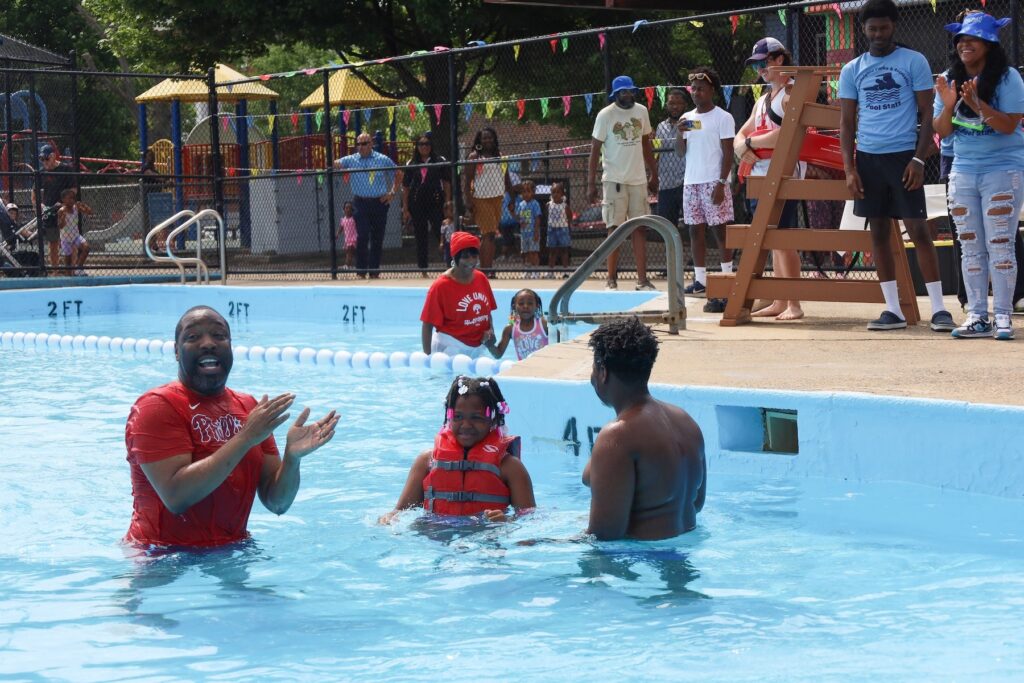From Philadelphia and the Pennsylvania suburbs to Southern New Jersey and Delaware, what neighborhoods would you like to see covered on WHYY News? Let us know!
Brother and sister Avery and Ashton Billups dove into the clear blue water at the deep end of the public pool at Chew Playground in South Philadelphia on a recent Monday morning.
They celebrated the pool’s opening with neighbors and local residents.
“It was cold, but not too cold,” 9-year-old Avery said of her first time in the water. “Sometimes. [Ashton] They do handstands in the water, and I do that too.”
“I do handstands, yeah,” said Ashton, 12. “I also do backflips in the water.”
The Billups siblings first learned to swim at a public pool here in Philadelphia that offers free lessons to neighborhood kids and a local summer camp program, and their mother, Angela Sawyer, said water safety has always been important to their family.
“It’s so important because anything could happen,” she said. “They could save a life and I could save a life.”
But a new federal report released earlier this month found that despite water safety awareness campaigns and efforts to teach more children and adults to swim, the number of toddler drowning deaths nationwide increased by 12% from 2020 to 2021.
The U.S. Consumer Product Safety Commission found that the majority of drowning deaths occur in children under the age of 5, and that about a quarter of all drowning deaths disproportionately occur among black children and teenagers.
The rising number of drownings, combined with an ongoing national lifeguard shortage and some local programs limiting or postponing swim lessons, have health and aquatics experts in the Delaware Valley region emphasizing the importance of basic water safety and drowning prevention.
“These things happen in seconds and without a sound,” Dr. Erin McKee, an emergency physician at Rutgers University New Jersey Medical School, said of drownings and other drownings.
Drowning risks and prevention
The risk of drowning is higher among children and adults who cannot or do not know how to swim, which is why McKee says simply learning basic water safety skills can help prevent fatal drownings.
“What we always wanted to teach little kids and big kids is to lie on your back and let your head rest. [above] “If you fall in the water, you’re going to die,” she said, “because if you have that skill, it just adds a little bit of time to how long it takes to get rescued.”
Of course, being a good swimmer is ideal, but not everyone has the same opportunities to learn, McKee said.
“You have to have access to a water source or a pool and be able to afford swim lessons or have a community that offers swim lessons,” she said. “Not everyone has access to them.”
Swimming lessons at Philadelphia’s public pools are free, an effort to eliminate financial barriers to water safety and training programs. Other local organizations, such as the Salvation Army’s Camden Kroc Center, also offer low-cost or financially assisted lessons.
At the Kroc Center in Camden, instructors offer swim lessons year-round for adults and infants as young as 6 months old.
Julienne Olivo, assistant manager of the swimming club, said many of the newcomers start with little or no swimming ability, some join because they are afraid of the water and swimming, while others simply want to improve their existing swimming skills.
“This program is designed to accommodate all of those people,” Olivo said.
The center’s instructors also provide education and awareness on basic water safety in a variety of swimming environments.
“One of the things we tell people is to stay vigilant,” said Salvation Army Maj. Richard Sanchez, “be aware of your surroundings. Just because there are people around doesn’t necessarily mean there are safety precautions in place.”
While the Camden center has full lifeguard staffing, the Salvation Army Kroc Center in Philadelphia has suspended swimming lessons “due to a shortage of qualified lifeguards to provide swimming lessons,” the center said in a statement on its website.

